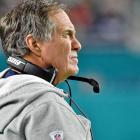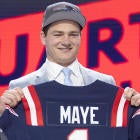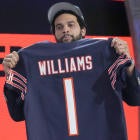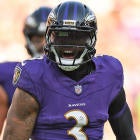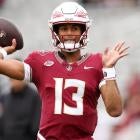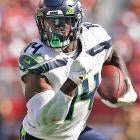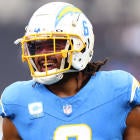After the 2018 NFL offseason, the AFC East remains the NFL's most predictable division. But how we got back to this point was anything but ordinary -- or for that matter, boring.
The Patriots could be forced to relocate to Mars, give the league a million bucks and a couple draft picks because of some mildly under-inflated footballs used during a 45-7 blowout (oh wait, that actually happened), and start every future game down seven points, and they'd still enter the 2018 season as the favorites to win the AFC East so long as Bill Belichick and Tom Brady are still steering the ship. The Patriots are still the kings, and the Bills, Jets, and Dolphins are all still floundering around as they wait for Belichick and Brady's historic run of dominance to end.
It's fitting then that we watched two of those teams -- the Bills and the Jets -- hit reset on their problematic quarterback situations this offseason while the Patriots prepared for yet another Super Bowl run. But it's not fitting that the Bills and Jets actually experienced more successful offseasons (to varying degrees) than the Patriots, though that certainly doesn't mean they're ready to overthrow the king -- far from it.
Welcome to the first installment of our divisional offseason reviews. We begin today with a look at the AFC East's offseason and how each team fared in their endeavor to improve their roster before the 2018 season.
This might come as a bit of a surprise, but the Patriots graded worse than the two New York-based teams. Meanwhile, the Dolphins had a fitting offseason by their standards: a couple moves that made sense, and more than a few that didn't quite make as much sense. It's funny, no matter how awful a Patriots offseason gets, so long as they don't lose Brady and Belichick, they'll retain their status atop the division. The other three teams, on the other hand, could have the best offseason in the league and they'd still come up short of the Patriots' standard. In that sense, the Dolphins, Bills, and Jets need to be planning ahead for the era after Brady and Belichick. Two of those three teams did exactly that over the past few months.
Below, you'll find an offseason review for each of the four teams -- including key additions, key losses, key rookies, a more general overview of what happened from February to May, and finally a grade for their offseasons. The other divisions will follow in the days to come.
We begin in Buffalo.
 Buffalo Bills
Buffalo Bills
- Key additions: QB AJ McCarron, DT Star Lotulelei, DE Trent Murphy, RB Chris Ivory, OT Marshall Newhouse, CB Vontae Davis, CB Phillip Gaines, C Russell Bodine, S Rafael Bush
- Key losses: QB Tyrod Taylor, OT Cordy Glenn, WR Jordan Matthews, WR Deonte Thompson, G Richie Incognito, C Eric Wood, LB Preston Brown, CB E.J. Gaines
- Key rookies: QB Josh Allen, LB Tremaine Edmunds, DT Harrison Phillips
It still seems strange to say, but the Buffalo Bills were somehow a playoff team in 2017, snapping their historic playoff drought with a Hollywood ending to the regular season before they fell short against the Jaguars during Wild Card Weekend. So, how did the Bills respond to their first playoff appearance since 1999?
They blew it all up.
The Bills created a gaping hole at quarterback by shipping starter Tyrod Taylor to Cleveland. To fill that self-created hole, the Bills watched the top free agent quarterbacks land elsewhere before they signed the last remaining bridge quarterback on the market in A.J. McCarron. They weren't done. In the draft, the Bills traded up to No. 7 to select Wyoming's Josh Allen -- a project quarterback with an arm as pure as Lannister gold that tends to misfire at an alarmingly high rate.
The Bills deserve credit for finally resetting at the quarterback position, but the way in which they went about replacing Taylor doesn't inspire much confidence. For all of the hype surrounding McCarron, he's still a career backup quarterback with three starts under his belt. For all of the hype surrounding Allen, his biggest strength is his arm talent -- a strength that doesn't automatically translate to success. Allen's entire body of work suggests he'll have trouble succeeding in the NFL. Nobody knows how Allen will adapt to the NFL -- the draft is a crapshoot -- but he appears to be the most-likely bust out of all the first-round quarterbacks based on his college resume.
Quarterback might've been the most important position for the Browns to fill, but don't overlook their decision to Bengals and Bills reportedly swap first-round picks in wild deal for Cordy Glenn, as well as the losses of guard Richie Incognito and center Eric Wood. The Bills did sign offensive tackle Marshall Newhouse as well as center Russell Bodine in free agency, but there's no doubt that the Bills' offensive line has gotten worse over the past few months. The receiver position remains especially problematic.
Josh Allen: 56% college completion rate
— Pat Thorman (@Pat_Thorman) April 28, 2018
Kelvin Benjamin: 56% career catch rate
Andre Holmes: 57% career catch rate
Zay Jones: 42% rookie yr catch rate
Gonna be like watching drunk walruses mate.
Defensively, the Bills did well to grab dynamic linebacker Tremaine Edmunds in the first round and defensive tackle Harrison Phillips in the third round. The free agent signings of defensive tackle Star Lotulelei, defensive end Trent Murphy, cornerback Vontae Davis, and cornerback Phillip Gaines all have huge upside, but they also all come with some risk attacked to them. Bringing long-time defensive tackle Kyle Williams back was a huge offseason win.
The Bills have put themselves in a position to succeed in the long term, but that future will likely come down to the development of Allen. If Allen develops into a franchise-saving quarterback, the Bills might hit their peak right when the Patriots are forced to say goodbye to Brady and Belichick. If Allen doesn't develop into a franchise-saving quarterback, the Bills will likely slip right back into a playoff-less existence. Unfortunately, Allen is joining a team that just saw their offensive line get gutted.
Offseason grade: C+
 Miami Dolphins
Miami Dolphins
- Key additions: DE Robert Quinn, G Josh Sitton, WR Danny Amendola, WR Albert Wilson, RB Frank Gore, C Daniel Kilgore, QB Brock Osweiler
- Key losses: WR Jarvis Landry, DT Ndamukong Suh, C Mike Pouncey, QB Jay Cutler, QB Matt Moore, LB Lawrence Timmons, TE Julius Thomas
- Key rookies: S Minkah Fitzpatrick, TE Mike Gesicki
It's difficult to view the Dolphins' offseason as a positive one.
They lost some of their best players in receiver Jarvis Landry (traded to Cleveland), defensive tackle Ndamukong Suh (released, later signed with the Rams), C Mike Pouncey (released, later signed with the Chargers). Losing three players like that would be tough for any team to overcome, but the Dolphins' response has been largely uninspiring. Robert Quinn is a nice addition, but the signing 35-year-old running back Frank Gore doesn't make much sense for a 6-10 team. After trading Jay Ajayi to the Eagles at last season's trade deadline, the Dolphins have failed to adequately replace him. Guard Josh Sitton is getting up there in age (31), but he will at least help solidify a bad offensive line. Meanwhile, Danny Amendola and Albert Wilson are both solid slot guys, but it's confusing as to why the Dolphins felt the need to sign both.
The draft, however, was the Dolphins' saving grace. Minkah Fitzpatrick is the kind of versatile defensive back that is perfect for today's NFL and he should bring an added dimension to the Dolphins' subpar defense. Their second-round pick, Mike Gesicki, has a chance to be the tight end Adam Gase thought he was getting when he brought in Julius Thomas.
Of course, their biggest addition will likely be quarterback Ryan Tannehill, who was on the roster last season, but missed the season with a torn ACL. If he improves off his career 2016 season, the Dolphins could become competitive again. Unfortunately for him, he's returning to a team that's gotten worse since he last played with them.
As mentioned earlier, the Dolphins shouldn't necessarily be in "win now" mode -- not with Brady and Belichick still around in the AFC East. They're a team that seems better suited for a full-on rebuild. They didn't do that this offseason and as a result, appear to be destined for another sub-.500 season. This is a team that got worse this offseason.
Offseason grade: D
 New England Patriots
New England Patriots
- Key additions: RB Jeremy Hill, DE Adrian Clayborn, OT Trent Brown, OT Matt Tobin, DT Danny Shelton, CB Jason McCourty, WR Cordarrelle Patterson, WR Jordan Matthews
- Key losses: CB Malcolm Butler, RB Dion Lewis, LT Nate Solder, WR Brandin Cooks, WR Danny Amendola, OT Cameron Fleming, DL Ricky Jean Francois
- Key rookies: OT/G Isaiah Wynn, RB Sony Michel, CB Duke Dawson, QB Danny Etling
Before we begin, it's important to reiterate that regardless of what happens to the Patriots in the offseason, as long as they're able to retain both Belichick and Brady, they're going to be the best team in the AFC East, probably the AFC, and maybe the NFL. With that being said, what a brutal offseason this was for the Patriots.
They got absolutely gutted in free agency, losing starting cornerback Malcolm Butler and the always elusive running back Dion Lewis to the Titans. Long-time left tackle Nate Solder signed with the Giants. Playoff hero and one of Brady's BFFs, Danny Amendola, is now a Dolphin. By their own volition, they sent speedy receiver Brandin Cooks to Los Angeles. There's no doubt that today's roster is worse than the roster they used during the 2017 season.
In typical Patriots fashion, they didn't recover from those losses by making splashy free agent signings like the Jets did. Instead, they bought low on some intriguing players. Clayborn is a former first-round pick who collected six sacks in a single game last season. Brown could be the Solder replacement. Shelton is a former first-round pick who hasn't looked like one yet, but nobody would be all that surprised if his move from Cleveland to New England sparked a change. Patterson could be another special teams ace. Hill could make Lewis' loss more manageable. McCourty can help replace Butler. None of these acquisitions are a sure thing, but the Patriots certainly know how to get the most out of their players.
Perhaps their most important additions came in the draft. Picking three times in the first 56 selections, they grabbed a stud offensive lineman (Wynn), another running back to add to their busy backfield (Michel), a cornerback to help replace Butler (Dawson), and heck, even a developmental quarterback (Etling). That's a nice haul.
Still, the fact remains that the Patriots lost at least five key players this offseason. Losing five key players would be a death blow to most teams. But the Patriots might the only team equipped to handle those departures. They won't get a high grade for the offseason, but nobody thinks a low-graded offseason will prevent the Patriots from journeying back to the postseason. They'll be back, alright.
The two biggest moves of the offseason: Tom Brady and Rob Gronkowski didn't retire. That matters.
Offseason grade: C
 New York Jets
New York Jets
- Key additions: QB Teddy Bridgewater, WR Terrelle Pryor, LB Avery Williamson, CB Trumaine Johnson, RB Isaiah Crowell, WR Andre Roberts, C Spencer Long
- Key losses: DE Muhammad Wilkerson, RB Matt Forte, TE Austin Seferian-Jenkins, DE Kony Ealy, linebacker Demario Davis K Chandler Catanzaro
- Key rookies: QB Sam Darnold, defensive tackle Nathan Shepherd, tight end Christopher Herndon
It's hard not to like what the Jets did this offseason. It's hard, however, to believe it. Ignore their recent history as one of the division's laughingstocks. What they did this offseason was improve a team that won five games and got outscored by 84 points last year.
Though they didn't win the Kirk Cousins sweepstakes, they rebounded by re-signing Josh McCown and signing Teddy Bridgewater, which gives them short-term security at the position. Then, they went out and traded up to the No. 3 pick, which they used on USC's Sam Darnold -- a quarterback many believed to be the best in the quarterback class. The Jets' quarterback room is awfully crowded now (there's an argument to be made that they didn't need to sign McCown), but at least they have flexibility. If Bridgewater looks healthy throughout camp and the preseason, they can start him at the beginning of the season to see what they have in him. If Bridgewater doesn't look healthy and Darnold doesn't look ready for the NFL, they can plug in McCown. If Darnold does look ready, they can get an early jump on the Sam Darnold Era by starting him immediately. No one actually knows if the Jets fixed their quarterback situation. But they've exhausted all possible options. For that, they deserve credit.
Whoever ends up starting for the Jets will join a much improved team. Pryor is a nice buy-low receiver despite his struggles in Washington last year. Crowell didn't break out the way I thought he would last season, but he's still a dynamic option coming out of the backfield. And the breakout could still be coming. Johnson is one of the league's best cornerbacks. Williamson was one of the prizes of this year's free agent class, and he's still only 26 years old. Keeping Morris Claiborne solidified their secondary.
The Jets got better this offseason. They signed a boatload of talent in free agency. And they might've solved their quarterback problem. They won the offseason in the AFC East.
Offseason grade: B+













